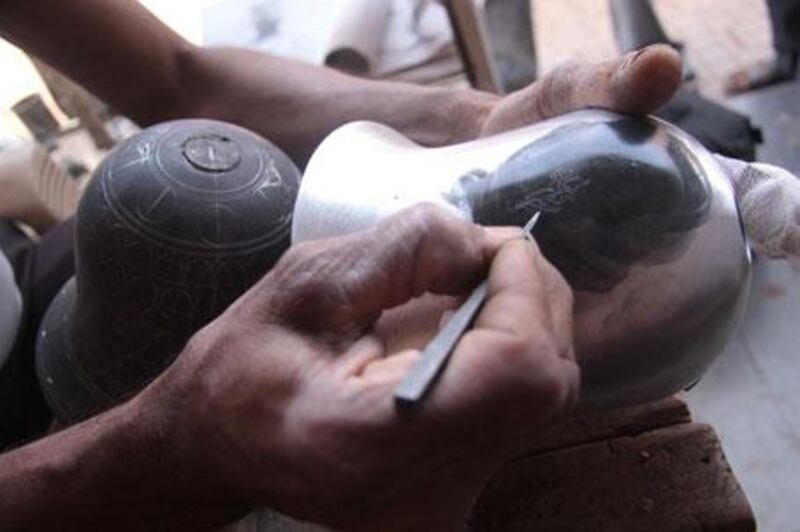Midur Rauf turns a round, black vase over in his hands, delicately tapping and carving a pattern from the surface to reveal a brilliant silver flower, sparkling through the dark background. Around him in his tiny workshop, craftsmen emboss intricately carved black elephants, dishes and traditional shisha pipes with silver leaf, or carve silver Mughal-esque patterns across the surfaces of blackened plates or vases.
"This art is 500 years old," Rauf explains, "And it is something my grandfather and my father did. It is a family tradition for me, and this type of work we are doing is found only in this town." The town is Bidar, small and dust-strewn in a remote corner of north-east Karnataka, its centre a developing hub, with fabric shops and internet cafes rubbing shoulders with fruit and chai stalls, and its outskirts bordered by ruined fortifications.
It boasts one of India's largest forts, a defensive outpost with huge gates, a mirrored palace hall, and room for 3,000 soldiers on its impressive ramparts, and is also home to a string of royal tombs from the 15th century Bahmani kingdom. Bidar is most famous, though, for its unique bidriware craftwork, a striking art that was developed by moulding mixtures of zinc, lead, copper, silver and tin, and using them to create vases, statuettes, ornamental boxes, goblets, dishes and jewellery. Pieces are blackened using a soil-based mixture, and then embossed with silver or decorated with designs engraved into the surface, to produce starkly beautiful black and silver patterns.
Bidriware designs typically borrow heavily from Islamic art and Mughal-era motifs, with solid geometric lines interspersed with depictions of flowers and vines. It is an ancient art dating back to the 1400s, but Bidar's contemporary artists are continuing to develop and sustain the town's most famous export. Along the city's Kulsum Galli Road, a busy street in Bidar's bustling Old City district, a group of bidri craftsmen sit in small workshops, delicately tapping and carving out patterns on thin and shining metal.
Muhammad Khurram runs the street's Central Bidri Works, hung with aluminium relief work and lined with examples of bidriware vases and jewellery. He explains the contemporary value of Bidar's artistic exports. "This art is only found in Bidar, and it is around 500 years old, and so has become very popular, and we have a growing export industry, shipping around India, and abroad. We sell to Europe - especially in Germany, France and Spain, and in America. We make a lot of money from exports, and from selling to craft emporiums in India - we are a small town but we have an important craft here. You won't find it anywhere else, so it's important to keep learning and training in the art."
Bidriware's popularity is indeed visible across Karnataka, and surrounding states, with craft outlets in large cities such as Andhra Pradesh's state capital, Hyderabad, displaying a huge range of bidri artwork. A long-standing art form, bidriware craftwork is often passed through families. The bidriware artist, Altif Rana, learnt the craft from his father. "This design and style of craft has always existed here, and it is only found here. Less people take up the art now, but there are still local artists who work to produce pieces.
"It has been passed through my family, from my grandfather to my father to me, and that is how a lot of artists here learn it - we try to pass it on and keep it going in families that have learnt the craft in the past." At Midur Rauf's Bidri Crafts workshop on Chowbara Road, Rauf follows a selection of traditional patterns and techniques that mirror the initial development of bidriware art form. "The patterns are ancient and developed over a long period, so we keep a lot of pictures, patterns and designs in the workshops, so we can easily follow traditional patterns, and produce the same pieces over and over again."
Introduced by the Persian Abdullah-bin-Kaiser, an artist among a group of skilled craftsmen brought to Bidar by Sultan Wali Bahmani during the 15th century rule of the Bahmani Kingdom, bidri craftwork quickly developed. The sultan was so impressed with the black and silver artwork that the Khwaja Mahmud Gawan Madrasa was built in 1492 to house and train bidriware craftsmen - the ruins remain, dominated by a towering, blue-tiled minaret and working mosque.
India's competitive handicraft industry is estimated to be expanding at around 18 per cent a year. Muhammad Khurram worries though that bidriware risks becoming a thing of the past in the face of growing competition. "It is very popular with tourists and we do export a lot of our art, but fewer people are doing this - this is why workshops here need to continue, to keep a unique craft in production. Bidar is famous for its silverwork, and we should try to keep it going."





